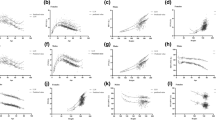Abstract
International guidelines recommend the use of population-specific reference values to eliminate the well-recognized influence of ethnic variation on lung function. This study was designed to derive spirometric prediction equations for healthy Omani adults. Forced vital capacity (FVC), forced expiratory volume in one second (FEV1), peak expiratory flow rate (PEFR), and forced expiratory flow at 25% to 75% of FVC (FEF25–75%) were measured in 419 “healthy” nonsmoking Omani adults (256 men, 163 women), aged 18–65 years. Multiple linear regression analysis was performed for each spirometric parameter against age, height, and weight for men and women separately, and prediction equations for all the above parameters were derived and compared with values derived using equations published from other populations. All measured spirometric parameters increased with height and decreased with age, and they were all significantly higher in men. In contrast, FEV1/FVC% values decreased with height and increased with age and were higher in women. The predicted normal values of FVC and FEV1 for our subjects using the derived equations were lower by 7–17% compared with respective Caucasian values, with smaller difference in the predicted values of PEFR, FEV1/FVC%, and FEF25–75%. This report presents previously unavailable spirometric reference equations for the Omani adults. Our findings highlight the need to use reference values based on updated data derived from relevant populations.

Similar content being viewed by others
References
Pellegrino R, Viegi G, Brusasco V, Crapo RO, Burgos F, Casaburi R, Coates A, van der Grinten CP, Gustafsson P, Hankinson J, Jensen R, Johnson DC, Macintyre N, McKay R, Miller MR, Navajas D, Pedersen OF, Wanger J (2005) Interpretative strategies for lung function tests. Eur Respir J 26:948–968. doi:10.1183/09031936.05.00035205
Crapo RO (2004) The role of reference values in interpreting lung function tests. Eur Respir J 24:341–342. doi:10.1183/09031936.04.00063804
Crapo RO (2005) Role of reference values in making medical decisions. Indian J Med Res 122:100–102
TS A (1995) Standardization of spirometry, 1994 Update. American Thoracic Society. Am J Respir Crit Care Med 152:1107–1136
Hankinson JL, Odencrantz JR, Fedan KB (1999) Spirometric reference values from a sample of the general U.S. population. Am J Respir Crit Care Med 159:179–187
Korotzer B, Ong S, Hansen JE (2000) Ethnic differences in pulmonary function in healthy nonsmoking Asian-Americans and European-Americans. Am J Respir Crit Care Med 161:1101–1108
Yang TS, Peat J, Keena V, Donnelly P, Unger W, Woolcock A (1991) A review of the racial differences in the lung function of normal Caucasian, Chinese and Indian subjects. Eur Respir J 4:872–880
Quanjer PH, Tammeling GJ, Cotes JE, Pedersen OF, Peslin R, Yernault JC (1993) Lung volumes and forced ventilatory flows. Report Working Party Standardization of Lung Function Tests, European Community for Steel and Coal. Official Statement of the European Respiratory Society. Eur Respir J Suppl 16:5–40
Sliman NA, Dajani BM, Dajani HM (1981) Ventilatory function test values of health adult Jordanians. Thorax 36:546–549. doi:10.1136/thx.36.7.546
Haddock D, Al-Hadramy M, Manchanda SB (1982) Normal spirometric values investigated in King Abul Aziz Teaching Hospital, Jeddah. Saudi Med J 3:159–170
Faris R, Hegazy N, Massoud A (1984) Normal values of ventilatory lung function tests among male Egyptians industrial workers. Respiratory News Bull 26:8–10
Abdullah A, Abedin M, Nouh M, Al-Nozha M (1986) Ventilatory function in normal Saudi Arabian adults: observations and comparisons with some western and eastern reference values. Trop Geogr Med 38:58–62
Shamssain MH (1988) Forced expiratory indices in normal Libyan men. Thorax 43:923–925. doi:10.1136/thx.43.11.923
Faris R, Elgewaily M, Gadallah M, Abbas H, Elkholi F (1990) Spirometric standards for healthy nonsmokers female industrial workers in Egypt. J Egypt Public Health Assoc 65:37–47
Burney PG, Luczynska C, Chinn S, Jarvis D (1994) The European community respiratory health survey. Eur Respir J 7:954–960
Memon MA, Sandila MP, Ahmed ST (2007) Spirometric reference values in healthy, non-smoking, urban Pakistani population. J Pak Med Assoc 57:193–195
Hansen JE, Sun XG, Wasserman K (2006) Ethnic- and sex-free formulae for detection of airway obstruction. Am J Respir Crit Care Med 174:493–498
Al-Riyami BM, Al-Rawas OA, Hassan MO (2004) Normal spirometric reference values for Omani children and adolescents. Respirology 9:387–391. doi:10.1111/j.1440-1843.2004.00608.x
Whittaker AL, Sutton AJ, Beardsmore CS (2005) Are ethnic differences in lung function explained by chest size? Arch Dis Child Fetal Neonatal Ed 90:F423–F428. doi:10.1136/adc.2004.062497
Woolcock AJ, Colman MH, Blackburn CR (1972) Factors affecting normal values for ventilatory lung function. Am Rev Respir Dis 106:692–709
Schoenberg JB, Beck GJ, Bouhuys A (1978) Growth and decay of pulmonary function in healthy blacks and whites. Respir Physiol 33:367–393. doi:10.1016/0034-5687(78)90063-4
Donnelly PM, Yang TS, Peat JK, Woolcock AJ (1991) What factors explain racial differences in lung volumes? Eur Respir J 4:829–838
Schwartz J, Katz SA, Fegley RW, Tockman MS (1988) Sex and race differences in the development of lung function. Am Rev Respir Dis 138:1415–1421
Aggarwal AN, Gupta D, Behera D, Jindal SK (2005) Applicability of commonly used Caucasian prediction equations for spirometry interpretation in India. Indian J Med Res 122:153–164
Boskabady MH, Keshmiri M, Banihashemi B, Anvary K (2002) Lung function values in healthy non-smoking urban adults in Iran. Respiration 69:320–326. doi:10.1159/000063271
Golshan M, Nematbakhsh M, Amra B, Crapo RO (2003) Spirometric reference values in a large Middle Eastern population. Eur Respir J 22:529–534. doi:10.1183/09031936.03.00003603
Acknowledgments
The authors thank Sultan Qaboos University Hospital Management and Professor M. O. Hassan, Head Department of Clinical Physiology, for the support and permission to use the Clinical Physiology Laboratory facilities to conduct the study and Oman Exhibition Center Management for granting our research team a dedicated booth for spirometric measurements free of charge. The authors also thank Mrs. R. Jothi, from the Department of Clinical Physiology for her assistance in spirometric measurements and data entry, and all the volunteers who participated in the study.
Author information
Authors and Affiliations
Corresponding author
Rights and permissions
About this article
Cite this article
Al-Rawas, O.A., Baddar, S., Al-Maniri, A.A. et al. Normal Spirometric Reference Values for Omani Adults. Lung 187, 245–251 (2009). https://doi.org/10.1007/s00408-009-9148-4
Received:
Accepted:
Published:
Issue Date:
DOI: https://doi.org/10.1007/s00408-009-9148-4




